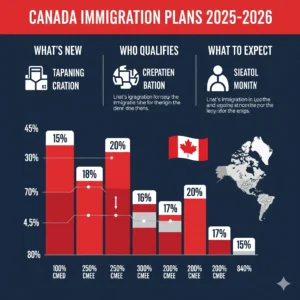Introduction
Canada is making major shifts in its immigration strategy for 2025-2026. With changing targets, revised pathways for permanent and temporary residents, updated policies on work permits and student admissions, and a growing emphasis on economic impact and sustainability, the new plan is setting a bold direction.
If you’re considering migrating to Canada, studying, or working temporarily there, understanding Canada Immigration Plans 2025-2026 is crucial. In this article, we break down what the plan includes, who it affects, what has changed, and how you can best prepare. At RankRise1.com, we aim to give you accurate, up-to-date information to make informed immigration decisions.
What Is the 2025-2027 Immigration Levels Plan?
One of the key foundations is the 2025-2027 Immigration Levels Plan, published by Immigration, Refugees and Citizenship Canada (IRCC). Government of Canada+2Government of Canada+2
Here are some of the highlights:
-
Permanent Resident (PR) targets are set to decrease compared to previous years:
• 395,000 in 2025 Government of Canada+1
• 380,000 in 2026 Government of Canada+1
• 365,000 in 2027 Government of Canada+1 -
For the first time, temporary resident targets (international students + temporary foreign workers) are formalized in the Plan. Government of Canada+1
-
One goal is to reduce the share of temporary residents to 5% of Canada’s total population by end of 2026. Government of Canada+1
-
There is greater emphasis on aligning immigration levels with housing, healthcare, and infrastructure capacity in various regions. Government of Canada+1
Key Changes & New Initiatives in 2025-2026
Beyond just numbers, the 2025-2026 period brings a number of policy changes, program reforms, and procedural updates.
-
Economic Immigration & Skilled Workers Priority
Canada is emphasizing economic contributions. Skilled workers, especially in in-demand sectors such as health, trades, technology, and social services, will be prioritized. Government of Canada+1 -
Student & Work Permit Reforms
-
Admission of international students will see caps / restrictions to better control pressure on services. Government of Canada+1
-
Post-Graduation Work Permit (PGWP) eligibility is under review to align with labor market needs. Erickson Immigration Group
-
Spousal open work permit policies are also being adjusted for spouses of students and foreign workers. Erickson Immigration Group
-
-
Temporary Residents & Pathways to Permanent Status
-
Increase in the proportion of permanent residence admissions coming from those already in Canada (students, temporary workers). Government of Canada+1
-
New or permanent pathways are being considered for certain skilled refugees and students. Erickson Immigration Group
-
-
Regional and Francophone Focus
-
A higher share of Francophone immigration targets outside Quebec. Government of Canada+1
-
More policies aimed at settlement in rural and northern communities to spread demographic growth more evenly. Government of Canada Publications+1
-
-
Digital Modernization & Service Improvements
-
Streamlined application processes, better client service, digital tools. Erickson Immigration Group+1
-
Better data and policy-driven decisions, responsiveness to public feedback. Government of Canada+1
-
How Does This Impact Applicants?
These changes will affect people differently depending on their current situation. Here’s what to watch for:
| Applicant Type | What’s Changing / What to Prepare |
|---|---|
| International Students | Watch for caps on student permits, stricter PGWP eligibility. Choose study programs aligned with labor market needs. Prepare finances carefully. |
| Temporary Foreign Workers | Work permit rules (especially for spouses) are changing; in-Canada experience may be more valued. Skills in demanded sectors give you a better chance. |
| Express Entry / Skilled Immigrants | Being already in Canada (on valid status) may give you advantage; selecting for specific skills/trades. Improve language ability & credentials. |
| Refugees & Humanitarian Applicants | Possible new pathways for students or skilled refugees; keep up with IRCC announcements. Humanitarian & refugee program commitments remain part of the plan. |
| Regions Outside Major Cities | Rural/northern and francophone communities may receive special focus; lower housing cost regions might be encouraged. |
Challenges & Considerations
While the plan offers clear direction, there are challenges and trade-offs:
-
Housing Shortage & Infrastructure Pressure: Critics warn that reducing immigration numbers does not immediately solve housing constraints; demand may still outpace supply. pbo-dpb.ca+1
-
Public Opinion & Social Capacity: As immigration levels are high, public sentiment in some areas is concerned about the costs of services (health, education). Balancing inclusion with capacity is a delicate task. migrationpolicy.org
-
Policy Execution Risks: Implementing caps, changing permit rules, and ensuring fairness takes time. Delays, bureaucratic backlogs, or legal pushbacks are possible.
-
Transition for Existing Temporary Residents: For those who expect to become permanent residents, changes might affect what was promised under older rules. Keeping up with changing eligibility is important.
Recent External Coverage & Reactions
To see how analysts and media are interpreting these changes, this live link gives you a deeper dive into some of the policy shifts:
Canada’s 2025-2026 Immigration Plan Sets Bold New Direction – ImmigCanada ImmigCanada
Moreover, official government sources like the IRCC’s Departmental Plan 2025-26 and Immigration Levels Plan 2025-2027 provide detailed metrics and goals. Government of Canada Publications+2Government of Canada+2
How to Prepare if You Plan to Immigrate
If you’re planning to take advantage of these immigration plans, here are some strategies to get ready:
-
Stay Informed: Regularly monitor IRCC announcements and official documents. Their “At A Glance” summaries are useful. Government of Canada
-
Choose Programs Wisely: Select study programs, jobs, or skills that align with Canada’s in-demand sectors. Having experience in Canada can help under the newer criteria.
-
Maintain Legal Status: If you’re already in Canada as a student or worker, ensure your permits are valid and that you comply with regulations—because future policy may favor those with in-Canada status.
-
Improve Your Application Profile: Strong language proficiency, relevant work/education credentials, proof of ability to integrate (e.g. official language skills, adaptability) can help.
-
Plan for Settlement & Costs: Housing, living costs, and settlement services will be critical. Regions outside big cities may offer more affordable options.
Internal Resource
For those interested in immigration policy, ranking websites, or digital resources related to Canada’s immigration, check out our coverage and guides on RankRise1.com for thorough analysis, tips, and updates.
Conclusion
Canada’s 2025-2026 immigration plans represent a shift toward more sustainability, better alignment with labor market needs, and stronger integration of temporary residents into permanent pathways. If you plan to immigrate, study, or work in Canada during this period, staying up to date, choosing strategies aligned with demand, and preparing well will be key.
The landscape is changing—and informed action will make all the difference.
References
-
Immigration, Refugees and Citizenship Canada: Supplementary Information for the 2025-2027 Immigration Levels Plan. Government of Canada
-
IRCC’s Departmental Plan 2025-26 “At a glance”. Government of Canada
-
ImmigCanada: Canada’s 2025-2026 Immigration Plan Sets Bold New Direction. ImmigCanada
-
Parliamentary Budget Officer: Impact of the 2025-2027 Immigration Levels Plan on Canada’s Housing Gap. pbo-dpb.ca
-
Migration Policy Institute (Canada’s policy challenges and public opinion). migrationpolicy.org

